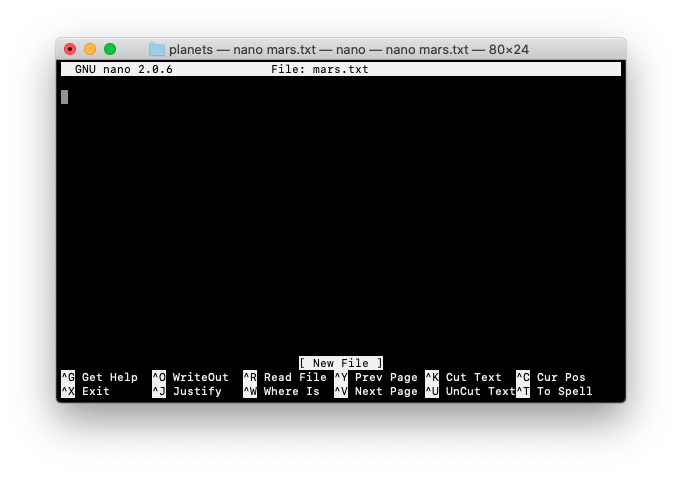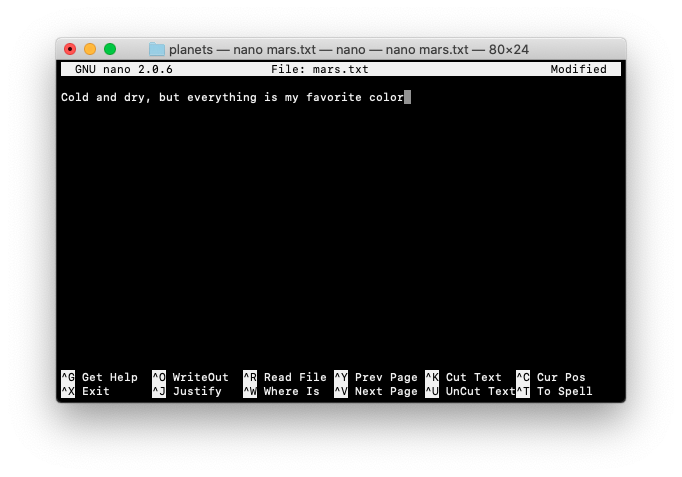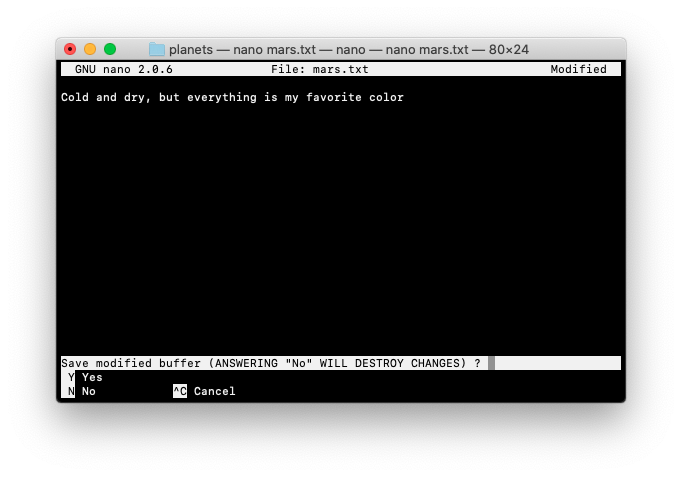Tracking Changes
Last updated on 2024-03-12 | Edit this page
Overview
Questions
- How do I record changes in Git?
- How do I check the status of my version control repository?
- How do I record notes about what changes I made and why?
Objectives
- Go through the modify-add-commit cycle for one or more files.
- Explain where information is stored at each stage of that cycle.
- Distinguish between descriptive and non-descriptive commit messages.
First let’s make sure we’re still in the right directory. You should be in the planets directory.
BASH
cd ~/Desktop/planetsCreate and edit a new file
Let’s create a file called mars.txt that contains some notes about the Red Planet’s suitability as a base. We’ll use nano to edit the file; you can use whatever editor you like. In particular, this does not have to be the core.editor you set globally earlier. But remember, the bash command to create or edit a new file will depend on the editor you choose (it might not be nano). For a refresher on text editors, check out “Which Editor?” in The Unix Shell lesson.
BASH
nano mars.txtType the text below into the mars.txt file:
OUTPUT
Cold and dry, but everything is my favorite colorLet’s first verify that the file was properly created by running the list command (ls):
BASH
lsOUTPUT
mars.txtmars.txt contains a single line, which we can see by running:
BASH
cat mars.txtOUTPUT
Cold and dry, but everything is my favorite colorCheck status
If we check the status of our project again, Git tells us that it’s noticed the new file:
BASH
git statusOUTPUT
On branch main
No commits yet
Untracked files:
(use "git add <file>..." to include in what will be committed)
mars.txt
nothing added to commit but untracked files present (use "git add" to track)The “untracked files” message means that there’s a file in the directory that Git isn’t keeping track of.
git add
We can tell Git to track a file using git add:
BASH
git add mars.txtand then check that the right thing happened:
BASH
git statusOUTPUT
On branch main
No commits yet
Changes to be committed:
(use "git rm --cached <file>..." to unstage)
new file: mars.txt
git commit
Git now knows that it’s supposed to keep track of mars.txt, but it hasn’t recorded these changes as a commit yet. To get it to do that, we need to run one more command:
BASH
git commit -m "Start notes on Mars as a base"OUTPUT
[main (root-commit) f22b25e] Start notes on Mars as a base
1 file changed, 1 insertion(+)
create mode 100644 mars.txtWhen we run git commit, Git takes everything we have told it to save by using git add and stores a copy permanently inside the special .git directory. This permanent copy is called a commit (or revision) and its short identifier is f22b25e. Your commit may have another identifier.
We use the -m flag (for “message”) to record a short, descriptive, and specific comment that will help us remember later on what we did and why. If we just run git commit without the -m option, Git will launch nano (or whatever other editor we configured as core.editor) so that we can write a longer message.
Good commit messages start with a brief (<50 characters) statement about the changes made in the commit. Generally, the message should complete the sentence “If applied, this commit will”
If we run git status now:
BASH
git statusOUTPUT
On branch main
nothing to commit, working directory cleanit tells us everything is up to date.
git log and git diff
If we want to know what we’ve done recently, we can ask Git to show us the project’s history using git log:
BASH
git logOUTPUT
commit f22b25e3233b4645dabd0d81e651fe074bd8e73b
Author: Vlad Dracula <vlad@tran.sylvan.ia>
Date: Thu Aug 22 09:51:46 2013 -0400
Start notes on Mars as a basegit log lists all commits made to a repository in reverse chronological order. The listing for each commit includes the commit’s full identifier (which starts with the same characters as the short identifier printed by the git commit command earlier), the commit’s author, when it was created, and the log message Git was given when the commit was created.
Where Are My Changes?
If we run ls at this point, we will still see just one file called mars.txt. That’s because Git saves information about files’ history in the special .git directory mentioned earlier so that our filesystem doesn’t become cluttered (and so that we can’t accidentally edit or delete an old version).
Now suppose Dracula adds more information to the file. (Again, we’ll edit with nano and then cat the file to show its contents; you may use a different editor, and don’t need to cat.)
We can see our new text in the mars.txt file
BASH
nano mars.txt
cat mars.txtOUTPUT
Cold and dry, but everything is my favorite color
The two moons may be a problem for WolfmanWhen we run git status now, it tells us that a file it already knows about has been modified:
BASH
git statusOUTPUT
On branch main
Changes not staged for commit:
(use "git add <file>..." to update what will be committed)
(use "git checkout -- <file>..." to discard changes in working directory)
modified: mars.txt
no changes added to commit (use "git add" and/or "git commit -a")The last line is the key phrase: “no changes added to commit”. We have changed this file, but we haven’t told Git we will want to save those changes (which we do with git add) nor have we saved them (which we do with git commit). So let’s do that now. It is good practice to always review our changes before saving them. We do this using git diff. This shows us the differences between the current state of the file and the most recently saved version:
BASH
git diffOUTPUT
diff --git a/mars.txt b/mars.txt
index df0654a..315bf3a 100644
--- a/mars.txt
+++ b/mars.txt
@@ -1 +1,2 @@
Cold and dry, but everything is my favorite color
+The two moons may be a problem for WolfmanThe output is cryptic because it is actually a series of commands for tools like editors and patch telling them how to reconstruct one file given the other. If we break it down into pieces:
- The first line tells us that Git is producing output similar to the Unix
diffcommand comparing the old and new versions of the file. - The second line tells exactly which versions of the file Git is comparing;
df0654aand315bf3aare unique computer-generated labels for those versions. - The third and fourth lines once again show the name of the file being changed.
- The remaining lines are the most interesting, they show us the actual differences and the lines on which they occur. In particular, the
+marker in the first column shows where we added a line.
After reviewing our change, it’s time to commit it:
BASH
git commit -m "Add concerns about effects of Mars' moons on Wolfman"OUTPUT
On branch main
Changes not staged for commit:
(use "git add <file>..." to update what will be committed)
(use "git checkout -- <file>..." to discard changes in working directory)
modified: mars.txt
no changes added to commit (use "git add" and/or "git commit -a")Whoops: Git won’t commit because we didn’t use git add first. Let’s fix that:
BASH
git add mars.txt
git commit -m "Add concerns about effects of Mars' moons on Wolfman"OUTPUT
[main 34961b1] Add concerns about effects of Mars' moons on Wolfman
1 file changed, 1 insertion(+)Git insists that we add files to the set we want to commit before actually committing anything. This allows us to commit our changes in stages and capture changes in logical portions rather than only large batches. For example, suppose we’re adding a few citations to relevant research to our thesis. We might want to commit those additions, and the corresponding bibliography entries, but not commit some of our work drafting the conclusion (which we haven’t finished yet).
To allow for this, Git has a special staging area where it keeps track of things that have been added to the current changeset but not yet committed.
Staging Area
If you think of Git as taking snapshots of changes over the life of a project, git add specifies what will go in a snapshot (putting things in the staging area), and git commit then actually takes the snapshot, and makes a permanent record of it (as a commit). If you don’t have anything staged when you type git commit, Git will prompt you to use git commit -a or git commit --all, which is kind of like gathering everyone to take a group photo! However, it’s almost always better to explicitly add things to the staging area, because you might commit changes you forgot you made. (Going back to the group photo simile, you might get an extra with incomplete makeup walking on the stage for the picture because you used -a!) Try to stage things manually, or you might find yourself searching for “git undo commit” more than you would like!
Let’s watch as our changes to a file move from our editor to the staging area and into long-term storage. First, we’ll add another line to the file:
BASH
nano mars.txt
cat mars.txtOUTPUT
Cold and dry, but everything is my favorite color
The two moons may be a problem for Wolfman
But the Mummy will appreciate the lack of humidityBASH
git diffOUTPUT
diff --git a/mars.txt b/mars.txt
index 315bf3a..b36abfd 100644
--- a/mars.txt
+++ b/mars.txt
@@ -1,2 +1,3 @@
Cold and dry, but everything is my favorite color
The two moons may be a problem for Wolfman
+But the Mummy will appreciate the lack of humiditySo far, so good: we’ve added one line to the end of the file (shown with a + in the first column). Now let’s put that change in the staging area and see what git diff reports:
BASH
git add mars.txt
git diffThere is no output: as far as Git can tell, there’s no difference between what it’s been asked to save permanently and what’s currently in the directory. However, if we do this:
BASH
git diff --stagedOUTPUT
diff --git a/mars.txt b/mars.txt
index 315bf3a..b36abfd 100644
--- a/mars.txt
+++ b/mars.txt
@@ -1,2 +1,3 @@
Cold and dry, but everything is my favorite color
The two moons may be a problem for Wolfman
+But the Mummy will appreciate the lack of humidityit shows us the difference between the last committed change and what’s in the staging area. Let’s save our changes:
git commit -m "Discuss concerns about Mars' climate for Mummy"OUTPUT
[main 005937f] Discuss concerns about Mars' climate for Mummy
1 file changed, 1 insertion(+)check our status:
git statusOUTPUT
On branch main
nothing to commit, working directory cleanand look at the history of what we’ve done so far:
git logOUTPUT
commit 005937fbe2a98fb83f0ade869025dc2636b4dad5 (HEAD -> main)
Author: Vlad Dracula <vlad@tran.sylvan.ia>
Date: Thu Aug 22 10:14:07 2013 -0400
Discuss concerns about Mars' climate for Mummy
commit 34961b159c27df3b475cfe4415d94a6d1fcd064d
Author: Vlad Dracula <vlad@tran.sylvan.ia>
Date: Thu Aug 22 10:07:21 2013 -0400
Add concerns about effects of Mars' moons on Wolfman
commit f22b25e3233b4645dabd0d81e651fe074bd8e73b
Author: Vlad Dracula <vlad@tran.sylvan.ia>
Date: Thu Aug 22 09:51:46 2013 -0400
Start notes on Mars as a basePaging the Log
When the output of git log is too long to fit in your screen, git uses a program to split it into pages of the size of your screen. When this “pager” is called, you will notice that the last line in your screen is a :, instead of your usual prompt.
- To get out of the pager, press Q.
- To move to the next page, press Spacebar.
- To search for
some_wordin all pages, press / and typesome_word. Navigate through matches pressing N.
Limit Log Size
To avoid having git log cover your entire terminal screen, you can limit the number of commits that Git lists by using -N, where N is the number of commits that you want to view. For example, if you only want information from the last commit you can use:
BASH
git log -1OUTPUT
commit 005937fbe2a98fb83f0ade869025dc2636b4dad5 (HEAD -main)
Author: Vlad Dracula <vlad@tran.sylvan.ia>
Date: Thu Aug 22 10:14:07 2013 -0400
Discuss concerns about Mars' climate for MummyYou can also reduce the quantity of information using the --oneline option:
BASH
git log --onelineOUTPUT
005937f (HEAD -> main) Discuss concerns about Mars' climate for Mummy
34961b1 Add concerns about effects of Mars' moons on Wolfman
f22b25e Start notes on Mars as a baseYou can also combine the --oneline option with others. One useful combination adds --graph to display the commit history as a text-based graph and to indicate which commits are associated with the current HEAD, the current branch main, or other Git references:
BASH
git log --oneline --graphOUTPUT
* 005937f (HEAD -> main) Discuss concerns about Mars' climate for Mummy
* 34961b1 Add concerns about effects of Mars' moons on Wolfman
* f22b25e Start notes on Mars as a baseExercises
Directories
Two important facts you should know about directories in Git.
1. Git does not track directories on their own, only files within them.
Try it for yourself:
BASH
mkdir spaceships
git status
git add spaceships
git statusNote, our newly created empty directory spaceships does not appear in the list of untracked files even if we explicitly add it (via git add) to our repository. This is the reason why you will sometimes see .gitkeep files in otherwise empty directories. Unlike .gitignore, these files are not special and their sole purpose is to populate a directory so that Git adds it to the repository. In fact, you can name such files anything you like.
2. If you create a directory in your Git repository and populate it with files, you can add all files in the directory at once by
BASH
git add <directory-with-files>Try it for yourself:
BASH
touch spaceships/apollo-11 spaceships/sputnik-1
git status
git add spaceships
git statusBefore moving on, we will commit these changes.
BASH
git commit -m "Add some initial thoughts on spaceships"To recap, when we want to add changes to our repository, we first need to add the changed files to the staging area (git add) and then commit the staged changes to the repository (git commit):
Answer 1 is not descriptive enough, and the purpose of the commit is unclear; and answer 2 is redundant to using “git diff” to see what changed in this commit; but answer 3 is good: short, descriptive, and imperative.
Committing Changes to Git
Which command(s) below would save the changes of myfile.txt to my local Git repository?
Option 1git commit -m "my recent changes"
Option 2git init myfile.txt git commit -m "my recent changes
Option 3git add myfile.txt git commit -m "my recent changes"
Option 4git commit -m myfile.txt "my recent changes"
- Would only create a commit if files have already been staged.
- Would try to create a new repository.
- Is correct: first add the file to the staging area, then commit.
- Would try to commit a file “my recent changes” with the message myfile.txt.
Committing Multiple Files
The staging area can hold changes from any number of files that you want to commit as a single snapshot.
- Add some text to
mars.txtnoting your decision to consider Venus as a base - Create a new file
venus.txtwith your initial thoughts about Venus as a base for you and your friends - Add changes from both files to the staging area, and commit those changes.
The output below from cat mars.txt reflects only content added during this exercise. Your output may vary. First we make our changes to the mars.txt and venus.txt files:
BASH
nano mars.txt
cat mars.txtOUTPUT
Maybe I should start with a base on Venus.BASH
nano venus.txt
cat venus.txtOUTPUT
Venus is a nice planet and I definitely should consider it as a base.Now you can add both files to the staging area. We can do that in one line:
BASH
git add mars.txt venus.txtOr with multiple commands:
BASH
git add mars.txt
git add venus.txtNow the files are ready to commit. You can check that using git status. If you are ready to commit use:
BASH
git commit -m "Write plans to start a base on Venus"OUTPUT
[main cc127c2]
Write plans to start a base on Venus
2 files changed, 2 insertions(+)
create mode 100644 venus.txtKey Points
-
git statusshows the status of a repository. - Files can be stored in a project’s working directory (which users see), the staging area (where the next commit is being built up) and the local repository (where commits are permanently recorded).
-
git addputs files in the staging area. -
git commitsaves the staged content as a new commit in the local repository. - Write a commit message that accurately describes your changes.



